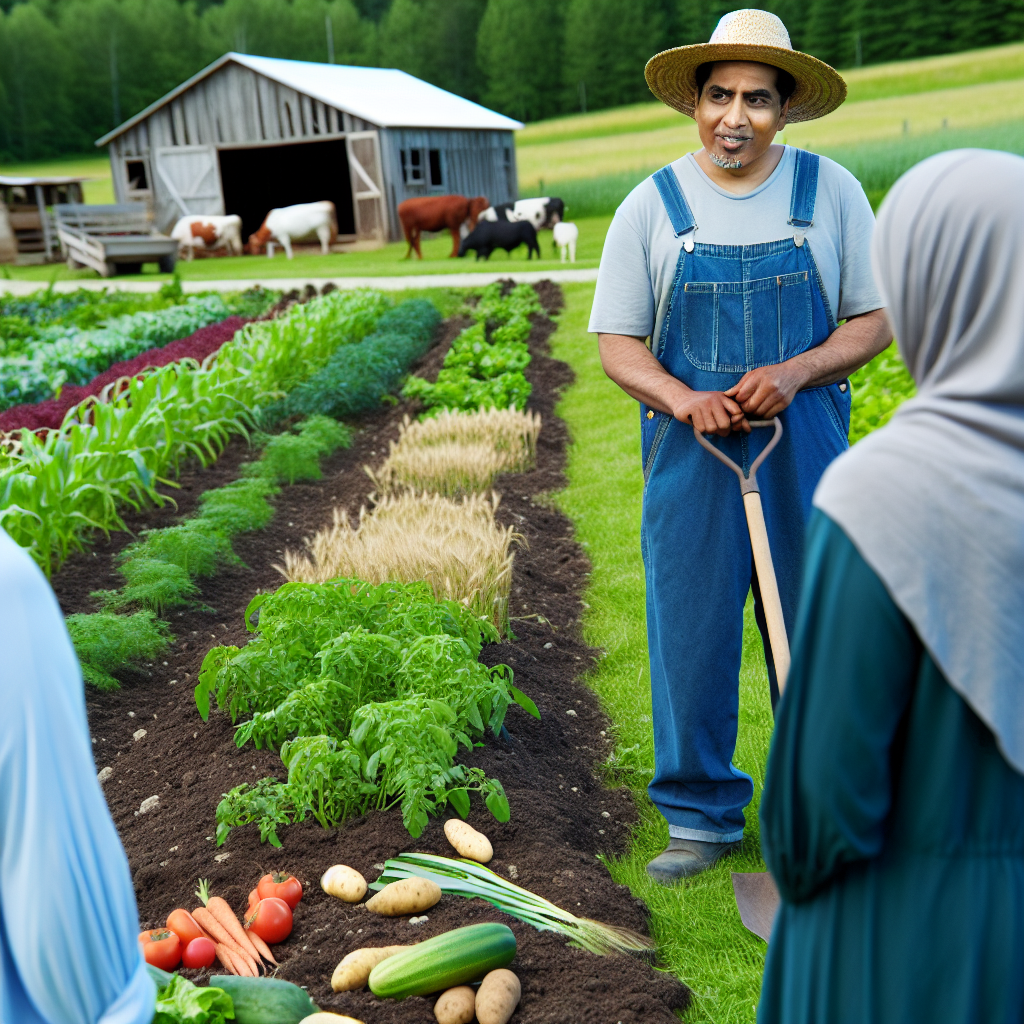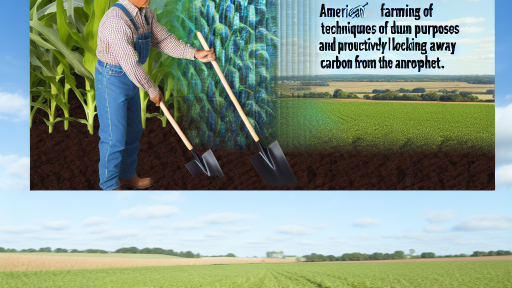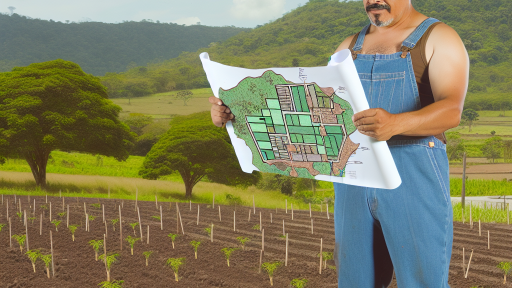Introduction to Cover Crops and Their Importance in Agriculture
Cover crops play a vital role in modern agriculture.
They improve soil health and reduce erosion.
Farmers use these crops to enhance biodiversity on their land.
Moreover, cover crops help manage weeds and pests naturally.
Defining Cover Crops
Cover crops are plants grown primarily for soil protection.
They are not intended for harvest like traditional crops.
Instead, they provide various ecological benefits when planted.
Common examples include clover, rye, and vetch.
Enhancing Soil Quality
Cover crops contribute to improved soil structure.
Their roots help break up compacted soil layers.
Additionally, they increase organic matter and nutrient content.
This process benefits subsequent crops in the growing season.
Supporting Biodiversity
Implementing cover crops boosts biodiversity on farms.
Various species can coexist, creating a more resilient ecosystem.
This diversity attracts beneficial insects and pollinators.
Transform Your Agribusiness
Unlock your farm's potential with expert advice tailored to your needs. Get actionable steps that drive real results.
Get StartedAs a result, healthier crop production emerges.
Contribution to Sustainable Farming Practices
Cover crops embody principles of sustainable farming.
They minimize the need for chemical fertilizers.
Thus, they help maintain ecological balance in farming areas.
Farmers are increasingly recognizing their long-term benefits.
Understanding Biodiversity and Its Significance in Farming Ecosystems
Defining Biodiversity
Biodiversity refers to the variety of life in a particular habitat or ecosystem.
This includes the various species of plants, animals, and microorganisms.
It also encompasses the genetic diversity within these species.
Ultimately, biodiversity contributes to the resilience of ecosystems.
The Importance of Biodiversity in Farming
Biodiversity plays a crucial role in agricultural productivity.
It enhances ecosystem services such as pollination and nutrient cycling.
Moreover, diverse farms are more resilient to pests and diseases.
This reduces the need for chemical inputs significantly.
Enhancing Soil Health
Diverse plant species contribute to healthier soils.
They improve soil structure and increase organic matter.
Healthy soils, in turn, support sustainable crop production.
Promoting Ecosystem Resilience
A rich variety of species allows ecosystems to adapt to changes.
Resilient ecosystems can better withstand extreme weather and climate shifts.
Thus, promoting biodiversity is vital for food security.
Supporting Food Diversity
Biodiversity in farming ensures a wider range of food products.
This variety can lead to improved nutrition for communities.
Additionally, it fosters local economies by supporting diverse crops.
Conservation of Resources
By maintaining biodiversity, we conserve genetic resources for future generations.
This biodiversity serves as a genetic reservoir for crop improvement.
Showcase Your Farming Business
Publish your professional farming services profile on our blog for a one-time fee of $200 and reach a dedicated audience of farmers and agribusiness owners.
Publish Your ProfileIt helps in developing new varieties that can withstand challenges.
Types of Cover Crops and Their Benefits for Biodiversity
Leguminous Cover Crops
Leguminous cover crops enhance soil fertility naturally.
They fix nitrogen in the soil, promoting plant health.
Additionally, they provide habitat for beneficial insects.
Examples include clover, vetch, and peas.
Grasses as Cover Crops
Grasses, such as rye and oats, prevent soil erosion effectively.
They improve soil structure, enhancing water retention.
Moreover, grasses contribute to a diverse root system.
This diversity boosts the resilience of the ecosystem.
Brassicas and Their Unique Benefits
Brassicas like radishes and mustard combat soil compaction.
They break up heavy soils with their deep roots.
Moreover, they suppress weeds and reduce pest populations.
Additionally, they can attract pollinators to your fields.
Cover Crop Mixtures
Using a mixture of cover crops maximizes benefits for biodiversity.
This approach combines various root structures and nutrient profiles.
Mixtures enhance soil health and support diverse wildlife.
Furthermore, they create a more resilient agricultural system.
Benefits Beyond Biodiversity
Cover crops reduce dependency on chemical fertilizers.
This leads to healthier ecosystems and cleaner water sources.
They also increase organic matter in the soil over time.
Ultimately, better soil health enhances crop yields sustainably.
Gain More Insights: Crop Rotation and Diversity: Key to Sustainable Farming
How Cover Crops Improve Soil Health and Contribute to a Diverse Ecosystem
Enhancing Soil Structure
Cover crops play a vital role in enhancing soil structure.
They create a network of roots that bind soil particles together.
This network improves aeration and water infiltration.
Moreover, healthier soil supports diverse microbial life.
Preventing Erosion
Cover crops serve as a protective layer against soil erosion.
They shield the soil from heavy rainfall and wind.
Consequently, this practice helps preserve topsoil richness.
As a result, farmers can maintain productivity over time.
Enhancing Nutrient Cycling
These crops contribute to efficient nutrient cycling.
They capture nutrients that would otherwise leach away.
For instance, legumes fix nitrogen in the soil.
This natural fertilizer reduces reliance on chemical inputs.
Supporting Biodiversity
By providing habitat, cover crops promote biodiversity.
They attract beneficial insects and other wildlife.
This diversity leads to a more resilient ecosystem.
Ultimately, it enhances pest control and pollination.
Managing Weeds and Pests
Cover crops effectively suppress weed growth.
They compete for light, water, and nutrients.
Showcase Your Farming Business
Publish your professional farming services profile on our blog for a one-time fee of $200 and reach a dedicated audience of farmers and agribusiness owners.
Publish Your ProfileAdditionally, certain species deter harmful pests.
This natural pest management reduces the need for pesticides.
Improving Soil Fertility
Through organic matter addition, cover crops enhance soil fertility.
Their decomposition releases essential nutrients slowly over time.
This steady release supports plant growth during critical stages.
Thus, crops achieve greater yields and quality.
Explore Further: Sustainable Techniques to Increase Farm Biodiversity
Integrating Cover Crops into Crop Rotation Plans
Understanding Cover Crops
Cover crops play a vital role in sustainable agriculture.
They improve soil health and enhance biodiversity.
Farmers can use various cover crop species for different benefits.
Benefits of Cover Crops
Cover crops help reduce soil erosion.
They contribute to nutrient cycling in the soil.
Additionally, they suppress weeds effectively.
Moreover, cover crops can enhance water retention in the soil.
Selecting Appropriate Cover Crops
Choosing the right cover crop is essential for effectiveness.
Farmers should consider soil type and climate conditions.
Legumes, for instance, can fix nitrogen in the soil.
Meanwhile, grasses may protect the soil from erosion.
Integrating Cover Crops into Rotation Plans
Integrating cover crops into existing rotation plans is beneficial.
Farmers should plan for cover crops between main crop cycles.
This practice enhances the biodiversity of the farming system.
Incorporating diverse species can improve resilience to pests.
Timing and Management Strategies
Proper timing is crucial for maximizing cover crop benefits.
Farmers should plant cover crops after cash crops are harvested.
Managing the growth of cover crops is also important.
Regularly checking for pests can promote healthy growth.
Monitoring Biodiversity Outcomes
After integrating cover crops, monitoring biodiversity is key.
Farmers can observe changes in pest populations and soil health.
Assessing plant diversity will provide valuable insights.
Long-term monitoring can lead to improved practices.
See Related Content: Benefits of Biodiversity in Modern Farming
Case Studies of Successful Cover Crop Implementation Promoting Local Wildlife
Enhancing Habitat for Pollinators
Farmers have successfully used cover crops to enhance habitats for pollinators.
For example, the Berry Family Farm implemented a mix of clover and vetch.
This combination has attracted various bee species to their fields.
As a result, crop yields have increased due to improved pollination.
Supporting Soil Health and Wildlife
Clover cover crops not only benefit crops but also support wildlife.
The Green Pastures Project planted cover crops to improve soil quality.
They noticed a significant increase in populations of beneficial insects.
Furthermore, earthworm activity has multiplied, enriching the soil.
Reducing Erosion and Creating Habitats
Cover crops play a vital role in reducing soil erosion.
Showcase Your Farming Business
Publish your professional farming services profile on our blog for a one-time fee of $200 and reach a dedicated audience of farmers and agribusiness owners.
Publish Your ProfileAt the Clear Lake Farm, they planted rye and buckwheat together.
This practice stabilized the soil and created habitats for small mammals.
In turn, these mammals contribute to a balanced ecosystem.
Increasing Biodiversity Through Diverse Cover Crop Mixes
Using diverse cover crop mixtures promotes greater biodiversity.
The Good Earth Initiative tested ten different cover crops on their farms.
The results showed a surge in both flora and fauna diversity.
More species attract different wildlife, creating a thriving ecosystem.
Discover More: How Crop Rotation Supports Sustainable Agriculture

Best Practices for Selecting and Managing Cover Crops to Maximize Biodiversity
Understanding Cover Crop Selection
Selecting the right cover crops enhances biodiversity in agricultural systems.
Choose species that are compatible with your main crops.
Additionally, consider whether the cover crops will attract beneficial insects.
Rotate cover crops each season to maintain soil health and prevent pests.
Furthermore, include a variety of species in your rotation.
This diversity can support a wider range of soil organisms.
Implementing Effective Management Techniques
Proper management of cover crops is essential for maximizing their benefits.
Monitor the growth and development of your cover crops regularly.
This allows for timely adjustments to management practices.
For instance, if a cover crop is underperforming, consider adjusting nutrient inputs.
Additionally, utilize appropriate tillage practices.
No-till methods can help preserve soil structure and biodiversity.
Timing and Termination Strategies
Timing plays a crucial role in the success of cover crops.
Terminate cover crops at the right growth stage to maximize benefits.
For example, terminating at flowering can enhance nutrient cycling.
Moreover, avoid late termination to prevent competition with main crops.
Consider employing different termination methods based on cover crop types.
Measuring Impact on Biodiversity
Regularly assess the impact of your cover crops on biodiversity.
Use various metrics to evaluate changes in soil health and ecosystem services.
For example, track the presence of pollinators and beneficial insects.
Additionally, monitor soil organic matter levels over time.
These observations can guide future cover crop decisions.
Engaging with the Community
Collaboration with local farmers can enhance biodiversity efforts.
Share successful cover crop strategies and learn from others’ experiences.
Consider participating in community seed exchanges.
This fosters the use of diverse and locally adapted cover crop species.
Participating in workshops allows for the exchange of innovative practices.
Challenges and Considerations in Using Cover Crops for Biodiversity Enhancement
Understanding Cover Crops
Cover crops are plants grown primarily for soil and environmental benefits.
They help improve soil quality and promote biodiversity.
However, their effective use requires careful planning.
Pest Management Issues
Cover crops can attract various pests.
Some pests might harm neighboring crops and reduce yields.
Showcase Your Farming Business
Publish your professional farming services profile on our blog for a one-time fee of $200 and reach a dedicated audience of farmers and agribusiness owners.
Publish Your ProfileFarmers must monitor pest populations closely.
Implementing integrated pest management strategies is essential.
Nutrient Management Considerations
Cover crops can impact soil nutrient levels for future crops.
Some crops may deplete soil nutrients rather than enrich them.
Farmers should select cover crops that suit their soil conditions.
Regular soil testing helps maintain appropriate nutrient levels.
Water Usage
Cover crops may compete with cash crops for water resources.
Understanding local hydrology is crucial in these decisions.
Choosing deep-rooted varieties can alleviate water competition.
Species Selection
The choice of cover crop species greatly influences biodiversity outcomes.
Diverse plant species attract various insects and pollinators.
Farmers should consider native species that thrive in local climates.
Timing and Management
Proper timing is critical for cover crop planting and termination.
Early termination may allow for better cash crop establishment.
Farmers need to develop a management plan that fits their schedules.
Economic Considerations
While cover crops provide long-term benefits, initial costs can be steep.
The investment in seed, equipment, and management can burden farmers financially.
Cost-sharing programs and subsidies can help offset these expenses.
Knowledge and Education
Many farmers lack knowledge about cover crop benefits and management.
Education and training programs can enhance understanding.
Networking with experienced growers can provide valuable insights.
Engaging local agricultural extension services promotes shared learning.
Future Trends in Cover Cropping
Increased Adoption of Diverse Cover Crops
Farmers increasingly recognize the benefits of planting diverse cover crops.
This trend promotes soil health and enhances biodiversity on farms.
As a result, farmers may experiment with various species to find the best combinations.
Moreover, these mixtures can improve pest management and reduce disease pressure.
For instance, mixing legumes with grasses can enhance nitrogen fixation and soil structure.
Technological Advancements in Cover Crop Management
Technology is revolutionizing cover crop management in agriculture.
New tools allow farmers to monitor growth and analyze soil health more effectively.
For example, drones provide aerial imagery for better planning and assessment.
Additionally, precision agriculture techniques help in optimizing planting and termination timings.
Consequently, farmers can maximize the ecological benefits of cover crops.
Integration with Climate-Smart Practices
Cover cropping aligns well with climate-smart agricultural practices.
These practices focus on reducing greenhouse gas emissions and enhancing resilience.
Farmers can use cover crops to improve water management and soil conservation.
This integration supports sustainable farming systems that adapt to changing climates.
Furthermore, using cover crops can help sequester carbon in the soil.
Support from Agricultural Policies
Government policies increasingly support the use of cover crops.
Incentives encourage farmers to adopt sustainable practices that improve biodiversity.
For instance, programs may provide financial assistance for planting cover crops.
Showcase Your Farming Business
Publish your professional farming services profile on our blog for a one-time fee of $200 and reach a dedicated audience of farmers and agribusiness owners.
Publish Your ProfileSuch measures can enhance the attractiveness of cover cropping for farmers.
In turn, this support can accelerate the transition toward sustainable agriculture.
Education and Knowledge Sharing
Education plays a critical role in promoting cover crops.
Extension services offer workshops and resources to help farmers understand their benefits.
Moreover, farmer-to-farmer networks foster knowledge sharing and collaboration.
These initiatives increase awareness of best practices in cover cropping.
Ultimately, better-informed farmers can implement more effective cover cropping strategies.
Additional Resources
Cover Cropping to Improve Climate Resilience | USDA Climate Hubs




